I’m right in the middle of rebuilding a Montague Boston as a fixed gear commuter. With all standard components, Montague bikes are really the only folding bikes out there that can be fully customized with any parts you want. I’ve stripped the frame down to the bare essentials, cleaned and regreased the headset, and prepared my new wheelset. Now I’m going to install the new bottom bracket and crankset.
I have a Shimano, square taper bottom bracket ready to go:
Most modern BBs use sealed cartridge bearings, so you won’t have any loose bearings to deal with. The sealed cartridge design is certainly easier to deal with, and keeps everything better protected from the elements. The drawback is that it doesn’t allow you to access the actual bearings to clean and regrease them. If they do start to go, you need to replace the cartridge.
The first thing to consider when choosing a bottom bracket and crankset, is what type your frame is made for. All Montague bikes, and a large number of bikes on the market now, use a 68mm, English threaded BB. 68mm is the width of the bottom bracket shell, and “English threaded” describes the size and spacing of the threads. Other frames (generally older, European frames) may have French, or Italian threads with a wider 70mm shell. Many new, high end road and mountain bikes are now using press fit bottom bracket cups that do not use threads at all. The spindle is then integrated with the crankset. The design provides weight savings, and apparently, increased stiffness.
Anyway, back to the task at hand. On this BB, the drive side cup is fixed, and the non-drive cup is separate. Make sure the threads in your frame are clean, and apply grease (or lock tight, or teflon tape). There are conflicting opinions on which is best, but I prefer good ol’ fashioned grease:
You should remember from removing the old BB, that the drive side is reverse threaded. You will need to turn the cup counter-clockwise to tighten it. Start by turning it in by hand to ensure it doesn’t cross thread. When necesary, switch to your splined BB tool. There are different tools for different bottom bracket designs, so make sure have the correct one:
You should use a torque wrench to tighten it with the torque specified by the BB manufacturer. In this case, it’s 50-70 N/m. Once that side is tight, grease the non-drive side cup, and start threading it in as well. This side uses standard threading, so clockwise will tighten it. Again, use the manufacturer’s specified torque:
Wipe off the excess grease, and you’re ready for a new crankset:
For this build, I have a set of All-City track cranks. They’re a solid, very durable single speed crankset, and although I went with black, they do come in a variety of colors:
With a square taper bb interface, crank installation is pretty simple. Just slide the crank arm on to the spindle:
Whether or not to grease the spindle is another one you’ll hear varying opinions about. Some say grease will actually allow you to over tighten the crank arm, making it very difficult to remove later. I went for the dry installation. With the crank arm in place, simply thread the crank bolt into the spindle, and tighten it down (again check what the manufacturer suggests for torque):
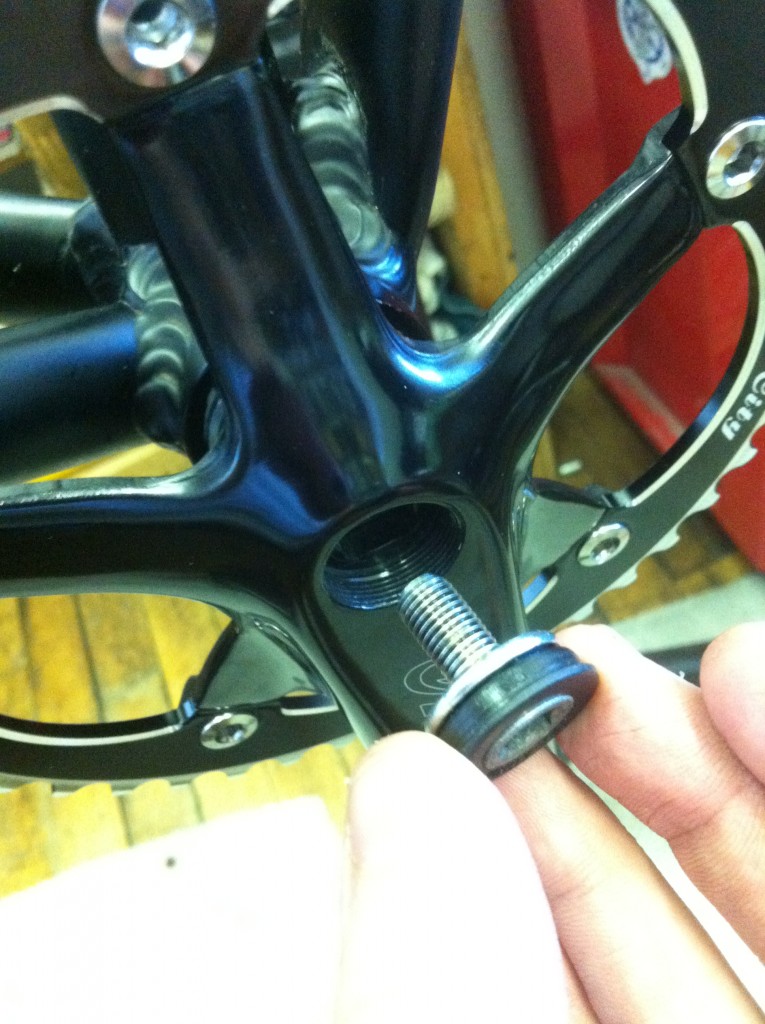 Install the other side in the same way, making sure the cranks are 180 degrees opposite of each other. The square taper spindle is symmetrical, so it is possible to rotate either crank arm by 90 degrees, but I guarantee you’ll find it difficult to ride that way. Next we’ll install the track cog on the rear wheel, mount them on the bike, and finish off the drive train with a nice new chain.
Install the other side in the same way, making sure the cranks are 180 degrees opposite of each other. The square taper spindle is symmetrical, so it is possible to rotate either crank arm by 90 degrees, but I guarantee you’ll find it difficult to ride that way. Next we’ll install the track cog on the rear wheel, mount them on the bike, and finish off the drive train with a nice new chain.


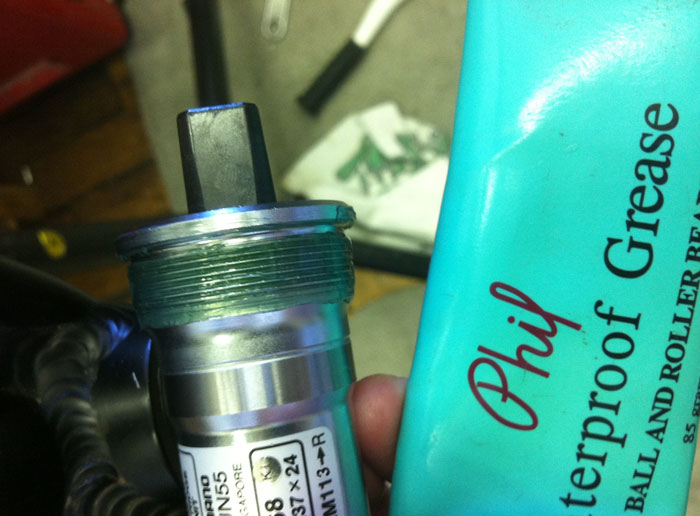
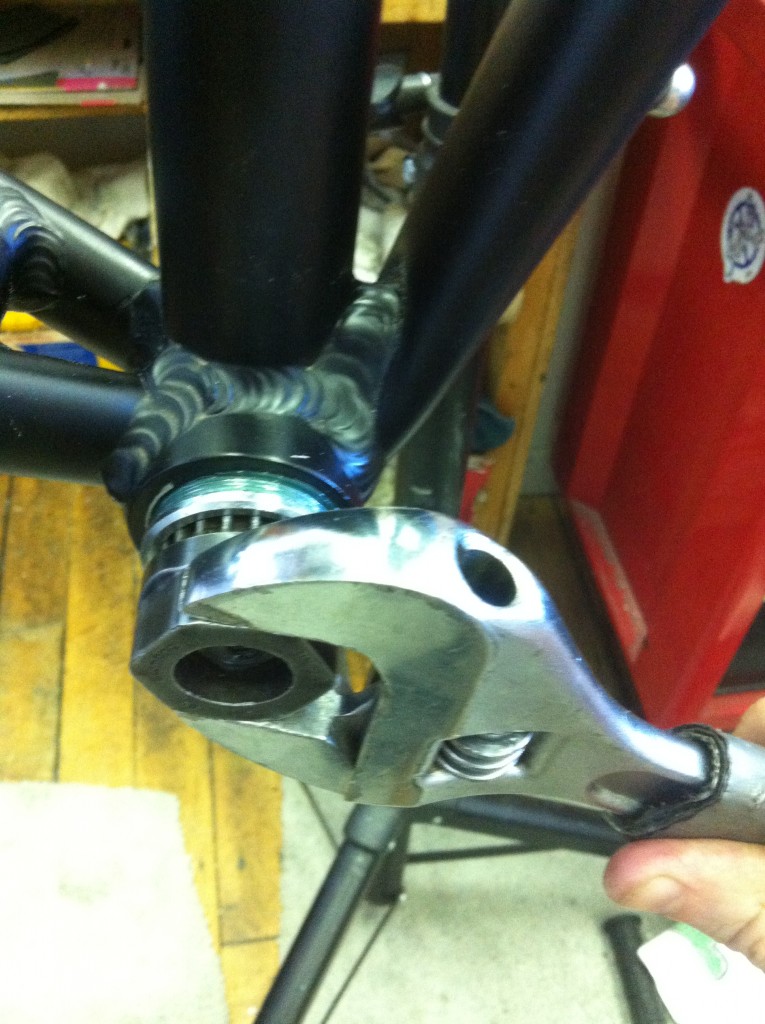
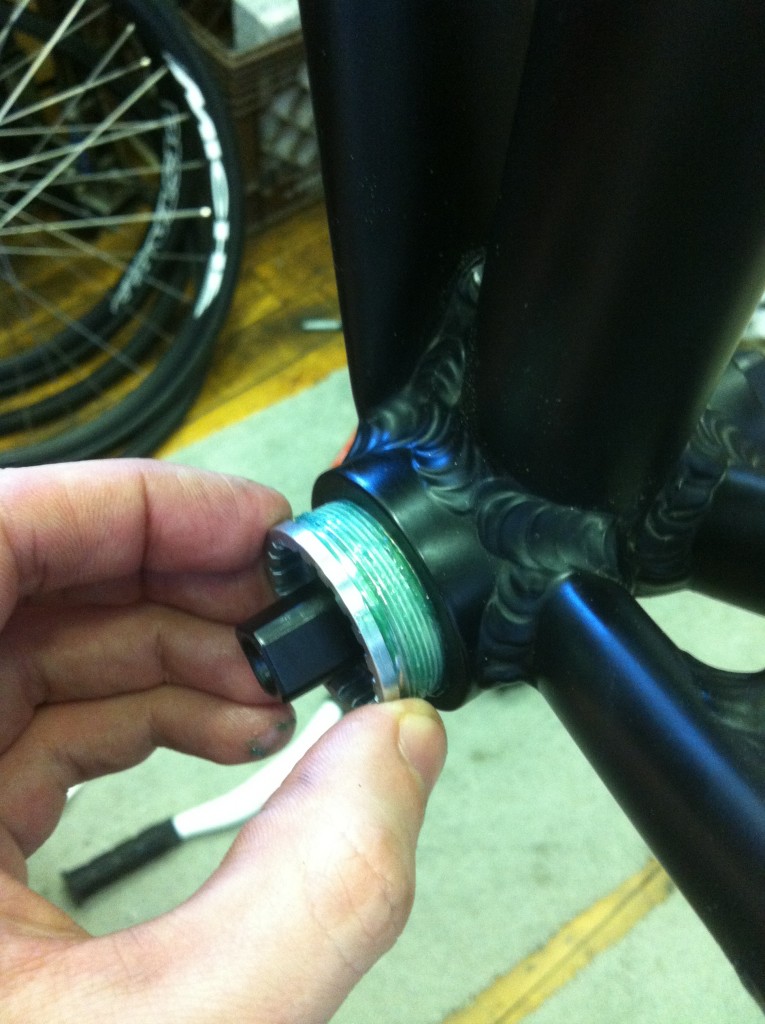
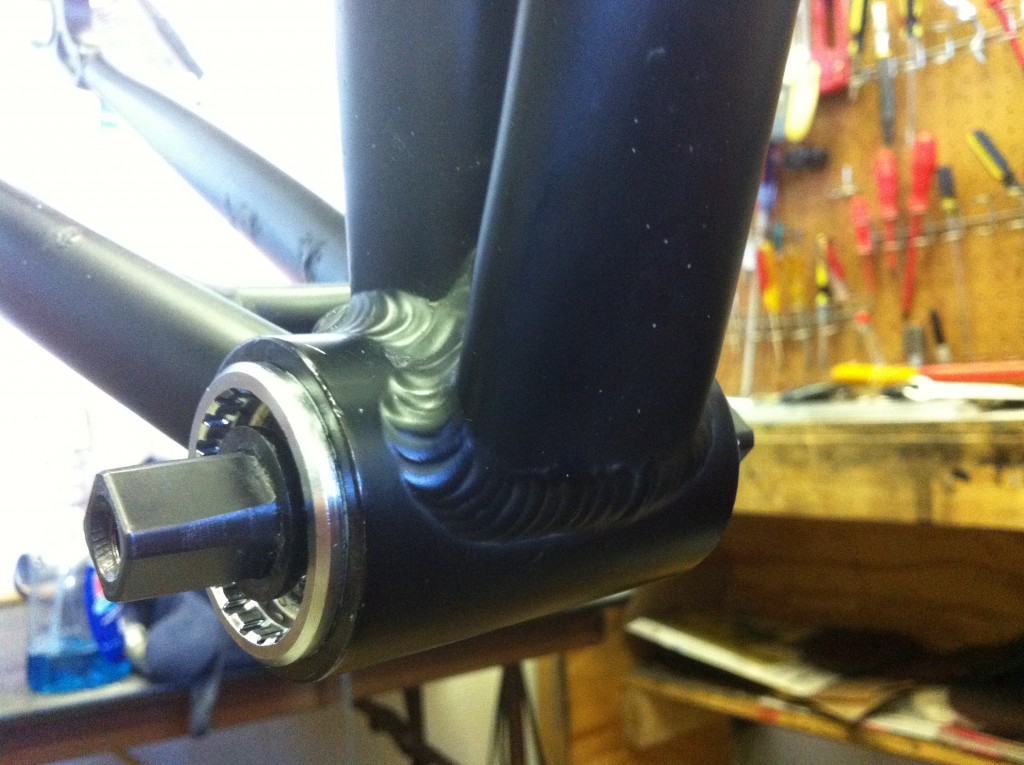

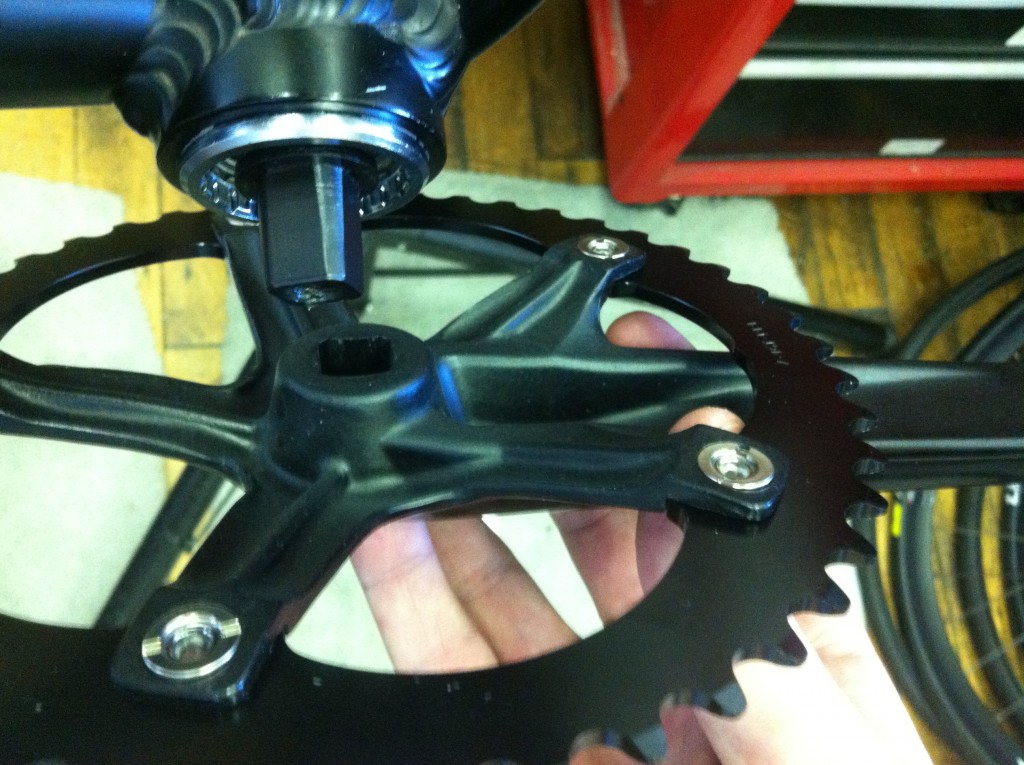

Thank you for this helpful guide to building a Montague bike! Looks like a lot of hard work does pay off!
Thankyou for showing me how easy it was to replace the BB. I’ve just replaced mine with a the BB-UN55 also.
Looking forward to smoother running on my way through hyde park tomorrow.
Excellent Andrew! Getting your hands dirty working on your bike, is half the fun of owning it (in my opinion!)
Thank you for stating the bottom bracket shell treading standard. I can now confidently go about swapping my existing bottom bracket with another and know what to buy!
I am interested in the single speed Boston. But I want to use a different gearing. I want to go slow, but have an easy time climbing hills. Can I find, and, fit a smaller crankset gear to allow this? 6 MPH, with lots of torque is what I want. Thanks!
You certainly could install a smaller chainring on the front, or even a larger freewheel in the rear to accomplish the lower gear ratio you’re looking for. Both are industry standard components so any bike shop could help you swap the parts.
Have a 2016 Paratrooper Pro, what size bottom bracket do I need? I know its a 68mm English thread, but not sure on the other size (107mm, etc…) planning on using the Shimano BB-UN55. I’m a heavier rider (290 lbs), will this be sufficient?
The spindle length would be 122.5mm. The Shimano UN55 is a great option for a replacement and should hold up for years to come.
I have a regular Paratrooper (04-‘05). Also planning on Shimano UN55, any chance you can provide BB size? Thx
That bike would use a 68mm English threaded bottom bracket with a 118mm spindle length. The crank interface should be square taper.
Hi Montague, I have a 2014 Paratrooper, could you advise on the spindle length for this please?
Spindle length should be 122.5mm, but a replacement within a mm or two should work fine.
I have a 1995 Biframe Crosstown and want to convert to the Shimano UN55, can you provide the spindle length I need to order? Thanks.
Hi Pat. Unfortunately, I don’t have specs that include spindle length for a model that old. However, if you pull the cranks from the existing BB, you should be able to measure it fairly easily.
I did as you suggested, pulled the spindle and it measured at 122.5 mm. Ordered a UN55 BB 68 x 122.5 mm, new Shimano Tourney TY501 crankset that matches up with the old Sakae that was on the original bike. Found the old BB bearings completely shot and rolling around loose inside the shell so no wonder the crankset was wobbly. Thanks.
I have to replace the bottom bracket on my Montague SwissBike X50.
Just two questions:
1. What kind of BB cartridge is installed on it?
2. Do the lock-rings on both sides have right threading?
Thank you in advance!
Hi Vladimir. Depending on the year of your X50 the exact brand might vary but it takes a 68mm English threaded BB with a square taper spindle. Spindle length is most likely 122.5mm but anything within a few mm of that should work fine for a replacement.
The BB cup on the the drive side is reverse thread, while the non-drive side cup is standard right hand threaded.
Thanks a lot for the information on BB type!
But my second question related to the lock-rings rather than BB cups. I meant the external rings covering the BB from the outside. They have 3 and 4 notches to apply a hook spanner for screwing/unscrewing.
Do they both have the right threading regardless of side?
Those lock rings thread into the bottom bracket shell of the frame and essentially act as the cups for that BB. Since it’s English threaded, that means the drive side is reverse thread, while the non-drive side is standard right hand threaded.
I am upgrading the crank set on my 2015 Navigator to a Shimano Acera FC-M371. Can I use the original BB cartridge or do I need to also replace this with a new one with a longer spindle?
It should work with the existing spindle.
So I recently bought a Montague Boston bike and have a friend who wants to help me put a different crank set on it. He wants me to find out what type of extractor tool is needed to remove the bottom bracket? Is it just a standard tool, or is something different needed?
Thank you.
A standard crank puller is all you’ll need. We recommend the Park Tool CCP-22.
I have a Crosstown from 2014. Also planning on Shimano UN55, any chance you can provide BB size? Thx
The bottom bracket on the Crosstown would be 68mm English threaded with a square taper crank interface and a spindle length of 122.5mm. Anything within a few mm of that spindle length would work fine.
Going to replace the bottom bracket on my partner’s Montague Urban bicycle bought new in 2018. I removed the bottom bracket and found that it is a Chin Haur brand, but could not find the spindle length listed anywhere. Could you please recommend a spindle length for a replacement bottom bracket for this Urban model? Thank you!
The bottom bracket on the Urban should have a spindle length of 122.5mm. Any 68mm English threaded BB with a square taper crank interface within a few mm of that spindle length would work fine.
I have two early 2000 Montague Folding bikes, I need to replace the crankset on one of them. What cranksets can I use?
Without knowing exactly what models you have, we can’t give a recommendation for a specific crank. However, we use standard cranks on all of our bikes, so any bike shop could supply a compatible replacement. You likely need a crank with a square taper spindle interface, but the number of chainrings and teeth depends on the model. You just want to match what was on there before.
So regarding my Boston Singlespeed I have (from early 2012), the replacement BB spindle length without altering the stock BB chainline is 113mm? I had it regreased a while back but I lost the stock BB measurement. I am looking for replacement options.
That is correct. 113mm spindle length for the Boston.
Hi I have a Montague Crosstown 2011.
I need to replace the bottom bracket. What size spindle length and thread size do I need?
Thanks
You would need a 68mm English threaded bottom bracket with a 122.5mm spindle length, although anything with a spindle within a few mm of that would work fine.
Thanks for that.
Hi,i have a gxp bb on my paratrooper pro,im having problems with it slipping,maybe i got the spacers wrong,i have one on each side,or i just fitted it wrong.i want to replace it and the cranks i use are for gxp,any advice please?
Can you clarify what you mean by the bottom bracket “slipping”? You may not need the spacers, which could be creating a chainline issue. If by slipping you meant that the BB is moving relative to the frame, it likely was not tightened down properly. They do require quite a bit of torque.
Hi,
I have a paratrooper and would like to change it to a 1x configuration. The original crank arm from Truvati x flow has an offset. Must i buy back a crank arm with a similar offset?
If you’re changing from a multi-ring crankset to a 1x setup, you will likely want a different “offset” on the new crank. If the new 1x crankset uses a GXP or Hollowtech crankset where there’s no spindle length to affect the position of the crank, the “chrainline” measurement will normally be listed in the specs. That’s the distance between the centerline of your frame and the centerline of the chainring. My understanding is that a single chainring chainline for 1x drivetrain with a 135mm rear hub should be in the range of 47.5 to 50mm for best shifting performance and wear.
I am riding the Montague Navigator(https://www.montaguebikes.com/product/navigator/).
Can I replace BB with 68mm English threaded bottom bracket with a 122mm spindle length?
That should work perfectly. The original spindle length is likely 122.5mm.
Hi I need to change a bent crank arm on a montague urban folding bike. Are the dimensions for the crank arm the same as the boston and do I need any special tools?
I am working on a Paratrooper 2005/2006 there is play in the crank. When I pulled what I thought would be a one piece cassette, I found a shaft with bearing on each end held in place with bearing race threaded in from each side. Is this normal or has someone changed it in the past? If it’s been changed what cassette does it use? If normal where can I get the replacement parts to rebuild it?
Hello, help – need to change out an x50 b/b, it’s the oem spec square taper spindle with bearing races and external lockrings.
The drive side has a 6 notch face, similar to a Park BBT-18 (8 notch, but can’t be made to fit).
What tool is required, as no bike shops seems to have it?
(at least in Europe, and already having about 6 different BB tools, have never come across it in more than 100 bikes)
Hi jon. It’s been a few years since we made that bike, but I believe the Park Tool BBT-4 would be the correct tool. Pedro’s also makes a “Shimano 6-Notch” BB tool which you should be widely available (Pedro’s item #6460250).
Hi Can you conform the correct bottom bracket for a single speed Boston purchased in dec 2014?
The Boston uses a 68mm English threaded bottom bracket with a square taper spindle, and that spindle length on the stock BB is most likely 118mm.
Would I be able to use a SHIMANO BB-UN300 BSA 68 square taper bottom bracket for chain case mounting with a 122mm spindle on my 2016 Paratrooper Highline? I am having a tough time finding the BB-UN55?
The crank on the Highline actually uses an Octalink bottom bracket interface rather than square taper. It’s still a 68mm English threaded shell on the frame, but you would want something like the Shimano BB-ES300 with a similar spindle length (approx. 121mm).
Hi besides the bb what model is the free hub. I have difficulty finding one that matches the original one. Nothing in the market looks the same or match the ori one. Thus I just have to service the ori one only. Would like to spare one.
I’m riding a montague paratrooper. Tks.
I have a Montague Navigator that I would like to upgrade the bottom bracket. What tool would I use to remove the Bottom Bracket? Do you have the part number or name?
Thanks.
Hi Randy. Compatible tools are available from several manufacturers, but they would need to be made for Shimano / ISIS Drive 20-tooth splined bottom bracket cups. I would recommend the Park Tool BBT-22 or BBT-32. The BBT-22 can be fitted directly onto a 3/8″ ratchet driver, which is nice.
Can I upgrade an old Crosstown fold mechanism to the latest DirectConnect™ folding system?
The frame is fundamentally different on the newer models that use the DirectConnect system, so unfortunately it’s not possible to upgrade one of our older bikes. The DirectConnect unit bolts into a threaded section of the rear half of the frame, and the piece that it clamps to is a specific shape that is integrated (welded) to the front half of the frame.